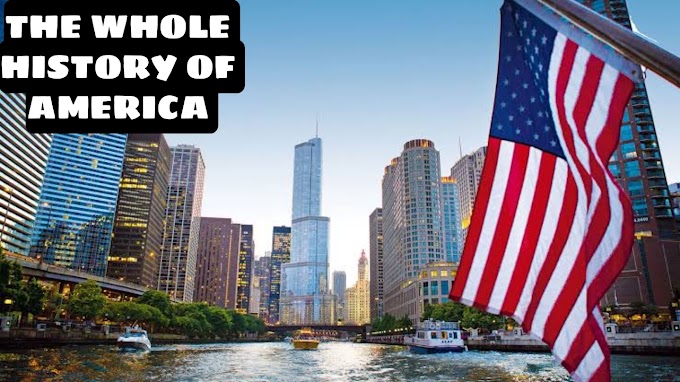THE WHOLE HISTORY OF INDIA
Hello Friends:
Welcome to Countries Facts so Today in this Article I will show you the whole history of India is filled with incredible stories of thriving civilizations religions and cultures dating all the way back to the paleoithic age india's civilization is one of the oldest that we know and has played a part on the world stage for centuries and even still today while it is impossible to truly capture all of india's history in one video it still serves as a worthy topic to delve into evidence of cave paintings and stone tools have revealed that the first signs of human activity in india can be traced back to somewhere between 400 000 and 200 000 bc details concerning the civilizations inhabiting the region back that long ago do not exist but we do know that one of the first sophisticated societies to walk the lands of india was the harappan people who likely existed throughout the first few thousand years bc positioned along the indus river the harappan people had their own writing system advanced social and economic system and impressive urban cities and architecture it is unknown why this civilization collapsed around 1500 bc but some attribute their demise to the common floods and other natural disasters in the region or potentially invaders from western and central asia the next known civilization to leave a mark on indian history books was the vedic aryans these people were initially migrants who spoke an early form of sanskrit and were determined to stay true to their own tribal identity the name they've been given the vedic people comes from four sacred texts or vedas that have presented researchers with a glimpse into the civilization's lives and beliefs these vedas are often considered to be the oldest hindu scripts and the vedic civilization is believed to have spread their culture across a large portion of india by roughly 1000 bc with them the vedic aryans brought their philosophical beliefs these ideas represent a theory that happiness and salvation come from a person's morals and ethics and one's path should be based upon their place in life but should always be righteous and good the vedic aryans also shared their societal system as they extended their reach this system was made up originally of three tears brahman or priest kashtriya or warrior and vaishia or commoner the aryans continued to spread their tribal settlements across india throughout the following centuries as their own civilization grew and flourished in both culture and trade a series of 16 individual settlements or states spanned across northern india including the gandhara kusala kuru and the magat the latter particularly flourished under the rule of chandragupta maurya during the 4th century bc as it began to expand and its leader grew his own authority and worked to form the mauryan empire which is believed to be the first indian imperial power the mauryan empire established its capital in battali putra near modern-day patna and constructed extraordinary temples libraries palaces and even a university the empire's trade success was impressive and it maintained a remarkable governmental system and strong army by the time of the third emperor the grandson of chandragupta a stance of non-violence was taken after a bloody struggle against the kingdom of kalinga due to the emperor's new buddhist beliefs siddhartha gautama the buddha had been born in 560 bc and by the reign of emperor ashoka the religious system he had founded was becoming more and more prevalent throughout india potentially due to their unwillingness to participate in conflict though the mauryan empire eventually dissolved in the 2nd century bc after the last line of the maurya line brihadratha was murdered by his commander-in-chief who would later found the shanga dynasty in 185 bc despite the fact that brihadratha's assassin pushy mitra was rumored to have persecuted buddhists it appeared that buddhism faced no decline concurrent with his rise to power during pushrumitra's reign his kingdom maintained authority over a series of provinces as he stood his ground against other powers attempting to expand their territory towards his own after the monarch's death though his dynasty seemed to have fallen in terms of importance the dynasty is not known to have done anything notably relevant and their control was short-lived a variety of settlements and invading powers controlled india at this time one being the kushana kingdom known for their significant trade involvement with chinese persian and roman empires along the silk road one kushana ruler konishka in the 1st century a.d also converted to buddhism and helps to further the religion throughout the region in 75 a.d the kushana kingdom marked a new era the shaka era a bit of distance from the kushanas in the south a handful of other powers rose fell and fought for supremacy amongst each other the kingdoms of satavahana chera chola and panja were some of the major authorities in the south during this time and through the classical age the gupta empire became the face of northern india during the classical age and the majority of the region was united under their authority during what is often described as northern india's golden age the reign of the gupta empire is regarded as a time of law and order as well as cultural flourishing the rulers of the empire were no strangers to military expedition but aims to expand their territory through peaceful means such as martial alliances no less than through military action though the gupta empire had extensive success over centuries they eventually reached a point of decline between the 5th and 6th centuries as invading huns from central asia began to annex and take over the formerly dominant empire's land as the religions of buddhism and what later became hinduism thrived local and trespassing authorities continued to fight for territory and dominion over the following centuries the next major shakeup of the indian civilization came with the arrival of islam muslim invaders began to send missions to india the century after the death of the prophet muhammad a series of muslim sultans began to lead expeditions into india claiming places such as sindh multan and samnath these incursions brought the defeat of native kingdoms and the destruction of hindu temples along the way the rajputs stood as one of the most determined defenders against sultan invaders but they were ultimately defeated in 1192 by muhammad gory and his forces as islam began to work its way into india other previously principal religions such as buddhism began to decline by the start of the 13th century the era of the delhi sultanates dominion arose the first dynasty within the delhi sultanate was founded by ketub ud din ibak the slave dynasty controlled the sultanate until around and 1290 when the khilji dynasty took over first by the hand of jahal ud-din khilji his family held the throne for less than a century as the tug lag dynasty was next to sea's power in 1320 the tuglak dynasty technically retained power until 1412 but matters were complicated by the incursion led by timur and 1398 into delhi as the tuglak dynasty weakened the saeed dynasty replaced them starting in 1414 the sayyids lasted for roughly 37 years but the last ruler's reign was stained by rebellion and discord as the dynasty fell from grace yet another dynastic authority took the open throne this time being the lodi dynasty the new dynasty lasted until the death of the then current ruler ibrahim khan lodi who was killed in battle at panipat by the army of kabul's leader babour in 1526 ibrahim's death brought about the final end of the delhi sultanate as a whole now free of competition from the lodi dynasty the board established the mughal dynasty which would end up becoming one of the greatest throughout history the original turkic mongol imperial power ruled a vast majority of india for over two centuries and brought about significant cultural growth and architectural achievements including the great taj mahal despite their immense success the mughal empire began its decline around the start of the 18th century as revolt after revolt began to shake the foundations of the widespread power alongside threats from the marathas and the british the british east india company had actually already been in the region for some time but the situation with the british started to escalate not long after the mughals fell by 1857 india displayed increasing control by the east india company and the locals were having none of it what began as a simple revolt by indian soldiers in merit quickly blew up into a widespread rebellion and became known as the indian mutiny of 1857. this rebellion later would be called the first war of indian independence and even though the british were able to quell the revolt after a matter of months it inevitably had lasting impacts in response to the mutiny on november 1 1858 britain's queen victoria declared that india would be ruled in the name of the british crown from that point on locals maintained their disapproval and anger at the british supremacy over their land and nationalist sentiments and movements were far from extinguished the next major move towards independence came when mahatma gandhi and the indian national congress decided to withdraw all cooperation with the british government beginning the non-cooperation movement following the end of world war one when this strategy did not bring the wanted results gandhi adopted a new technique in the form of the civil disobedience movement in december of 1929. essentially the movement was made up of the declaration of an indian independence day that would be celebrated on january 16th and complete disobedience of any orders by the british government again gandhi's strategy failed and this time he was even arrested while many other rebels were murdered still the british were eventually pushed into the round table conferences beginning in november of 1930 the second of which gandhi attended the conferences marked another failure and civil disobedience reignited gandhi's next attempt the quit india movement again made no drastic progress world war ii brought about new issues as india was forced into war by the british but at the conflict's conclusion a new labour party came into power in india and showed sympathy towards the fight for independence finally as august 14th turned to 15th in 1947 india became an independent nation I hope you guys this Article will be useful for you we will see you tomorrow in the next one have a great day bye.
















